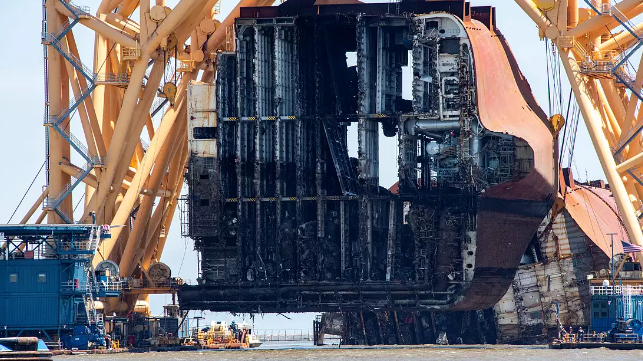Photos: Salvors Hoist and Remove Golden Ray's Engine Room Section

On Tuesday, salvors hoisted and removed the engine room section of the grounded ro/ro Golden Ray, loading it onto a deck barge for transport to a recycling facility in Louisiana.
The lift marks the culmination of a long, three-month process to saw through the heavily-reinforced hull section using a length of anchor chain. After multiple setbacks and pauses for repairs, the section was finally severed on April 24.
Over the weekend, the team moved ahead with operations to remove the section's cargo (vehicles), its moveable decks and accumulated sediment, lightening it for hoisting. The section was lifted and placed carefully on a barge on Tuesday, then towed to the nearby Mayors Point Terminal for sea-fastening in preparation for a final voyage to the Gulf Coast.





Images courtesy St. Simons Sound Incident Response
Collected data from fixed monitors and hydrographic surveys confirms that the remaining wreck is stable, the salvors said. The team will shift the heavy lift barge VB-10000 to the other end of the wreck and prepare the cutting rig for work to remove the next section in the sequence - the third back from the bow.
As expected, a limited amount of fuel oil escaped from the vessel during the lifting and removal evolution, and skimmers and shore teams responded. Six bags of oiled vegetative matter were removed from the shoreline on St. Simons Island.


Images courtesy St. Simons Sound Incident Response
The salvors must still complete three cuts, four section hoists and a seabed debris cleanup before the wreck removal process is completed. The commercial salvor for the project told AP that the work will continue for at least several more months, taking the effort into its second hurricane season.
The Golden Ray went aground and partially capsized in Georgia's St. Simons Sound on September 7, 2019. During an outbound transit in calm conditions, a routine turn to starboard turned into a runaway maneuver, ending with the vessel aground and resting on her side.
Lt. Ian Oviatt, a staff engineer at the Coast Guard Marine Safety Center, told the NTSB that the vessel had taken on too little ballast for her cargo load. “The cause of the vessel capsizing was lack of righting energy due to the way the vessel was loaded,” Oviatt told an investigative panel last September. “The vessel could have taken on additional ballast to be in compliance.”
